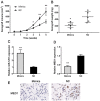MicroRNA-1291 mediates cell proliferation and tumorigenesis by downregulating MED1 in prostate cancer
- PMID: 30867757
- PMCID: PMC6396213
- DOI: 10.3892/ol.2019.9980
MicroRNA-1291 mediates cell proliferation and tumorigenesis by downregulating MED1 in prostate cancer
Abstract
miRNAs are important factors involved in the regulation of tumor development. miR-1291 was found to have regulatory effects in many tumors, but its role in prostate cancer (PCa) still remains unclear. We explored the expression of miR-1291 in PCa to reveal its role in regulating the progression of PCa as well as its underlying mechanism. Reverse transcription-quantitative polymerase chain reaction (RT-qPCR) was used to detect the expression of miR-1291 in PCa tissues and cell lines compared to normal tissues and cell lines. miR-1291 mimics and inhibitors were applied to overexpress or inhibit the level of miR-1291 in PCa cells. The ability of cell proliferation was measured using MTT assay, and cell cycle distribution was determined by flow cytometry. The potential target of miR-1291 was identified via western blot analysis and luciferase assays. Then a xenograft model was established to explore the function of miR-1291 in PCa in vivo. The results revealed that the expression level of miR-1291 was significantly lower in the PCa tissues than that in the normal adjacent tissues. In PCa-derived cells, there was also a downregulated expression level of miR-1291. Overexpression of miR-1291 obviously inhibited DU-145 cell proliferation and induced cell cycle transition from G0/G1 to S phase. However, inhibition of miR-1291 promoted the growth of LNCaP cells, and promoted the cell cycle transition to S phase and G2/M phase. MED1 was proven to be a potential target gene of miR-1291, and miR-1291 significantly inhibited its expression. At the in vivo level, overexpression of miR-1291 inhibited the growth of xenograft tumors and significantly inhibited the expression of MED1 protein. Our study demonstrated that miR-1291 inhibits cell proliferation and tumorigenesis of PCa via MED1, which might provide a novel target for PCa diagnosis and biological therapy.
Keywords: MED1; miR-1291; proliferation; prostate cancer; tumorigenesis.
Figures






Similar articles
-
MicroRNA-132/212 Upregulation Inhibits TGF-β-Mediated Epithelial-Mesenchymal Transition of Prostate Cancer Cells by Targeting SOX4.Prostate. 2016 Dec;76(16):1560-1570. doi: 10.1002/pros.23241. Epub 2016 Aug 16. Prostate. 2016. PMID: 27527117
-
MicroRNA-144-3p inhibits cell proliferation and induces cell apoptosis in prostate cancer by targeting CEP55.Am J Transl Res. 2018 Aug 15;10(8):2457-2468. eCollection 2018. Am J Transl Res. 2018. PMID: 30210684 Free PMC article.
-
MicroRNA-193a-3p inhibits cell proliferation in prostate cancer by targeting cyclin D1.Oncol Lett. 2017 Nov;14(5):5121-5128. doi: 10.3892/ol.2017.6865. Epub 2017 Sep 1. Oncol Lett. 2017. PMID: 29142597 Free PMC article.
-
MicroRNA-211 suppresses prostate cancer proliferation by targeting SPARC.Oncol Lett. 2018 Apr;15(4):4323-4329. doi: 10.3892/ol.2018.7877. Epub 2018 Jan 26. Oncol Lett. 2018. PMID: 29541199 Free PMC article.
-
Micro-ribonucleic acid 29b inhibits cell proliferation and invasion and enhances cell apoptosis and chemotherapy effects of cisplatin via targeting of DNMT3b and AKT3 in prostate cancer.Onco Targets Ther. 2015 Mar 4;8:557-65. doi: 10.2147/OTT.S76484. eCollection 2015. Onco Targets Ther. 2015. PMID: 25784815 Free PMC article.
Cited by
-
MicroRNA-1291-5p Sensitizes Pancreatic Carcinoma Cells to Arginine Deprivation and Chemotherapy through the Regulation of Arginolysis and Glycolysis.Mol Pharmacol. 2020 Dec;98(6):686-694. doi: 10.1124/molpharm.120.000130. Epub 2020 Oct 13. Mol Pharmacol. 2020. PMID: 33051382 Free PMC article.
-
Small Nucleolar Derived RNAs as Regulators of Human Cancer.Biomedicines. 2022 Jul 28;10(8):1819. doi: 10.3390/biomedicines10081819. Biomedicines. 2022. PMID: 36009366 Free PMC article. Review.
-
MiR-543/Numb promotes proliferation, metastasis, and stem-like cell traits of prostate cancer cells.Am J Transl Res. 2021 Feb 15;13(2):617-631. eCollection 2021. Am J Transl Res. 2021. PMID: 33594313 Free PMC article.
-
Long Non-Coding RNAs H19 and HOTAIR Implicated in Intervertebral Disc Degeneration.Front Genet. 2022 Mar 3;13:843599. doi: 10.3389/fgene.2022.843599. eCollection 2022. Front Genet. 2022. PMID: 35309146 Free PMC article.
-
HCP5, as the sponge of miR-1291, facilitates AML cell proliferation and restrains apoptosis via increasing PIK3R5 expression.Hum Genomics. 2021 Jun 29;15(1):38. doi: 10.1186/s40246-021-00340-5. Hum Genomics. 2021. PMID: 34187569 Free PMC article.
References
-
- Garisto JD, Klotz L. Active surveillance for prostate cancer: How to do it right. Oncology (Williston Park) 2017;31:333–340, 345. - PubMed
LinkOut - more resources
Full Text Sources
